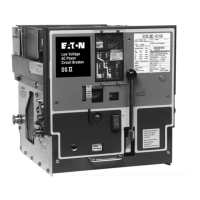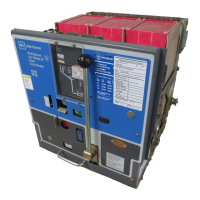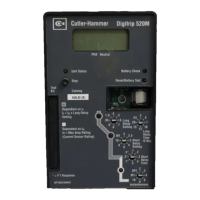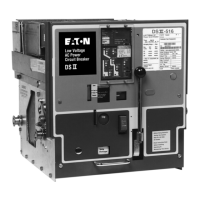I.
B.
694C694-02
I I
l.. ..;
CD
Ratchet Wheel
®Hold
Pawl
@ Stop Bracket
0 Emergency Charge Device
® Emergency Charge Pawl
@ Emergency Charge Handle
---~
-======
-
-====\:::::,,,
Page
31
Figure 4-8 Emergency Spring-Charge on Power Operated Mechanism
The angular position of the close cam in Figure 4-7 corre-
sponds to the angular position of the drive plates and
closing spring crank arms shown in Figure
4-6. The trip
latch is in the tripped position and it will reset to the
latched position at the end of the spring charging stroke.
The closing springs are charged by counterclockwise
rotation of the ratchet and drive plates until the close cam
stop roller meets the spring release latch, as shown in
Figure
4-7b.
Note in Figure 4-7b also that the lower end of the main
drive link with the main roller has swung upward and
toward the left, pushing the trip latch constraining link
so
as
to
rotate the trip latch back to the reset position. This
occurs at the same time that the spring charge is com-
plete and just before the close cam stop roller strikes
the spring release latch. The position of the cam in
Figure
4-7b corresponds to the position of the drive
plates in Figure
4-6a spring charged, breaker open.
The breaker is now ready to be closed. Closing is start-
ed by counterclockwise rotation of the spring release
latch (Figure
4-7b). This removes the hold on the close
cam stop roller, and allows the force of the closing
springs to rotate the close cam counterclockwise and
close the breaker. The linkage is then in the position
Effective
07
/97
shown in Figure 4-7c. The close cam has rotated
approximately 180 degrees.
The spring release latch can be rotated
by
two methods:
1.
Spring Release Device (Paragraph 3-10.2, Figures
4-
4 and 4-14)
2. Close Bar (through linkage shown in Figure 4-14b)
4-4 OPENING (TRIPPING) MECHANISM
The breaker is tripped open by counterclockwise rota-
tion of the trip shaft (Figure
4-7c). The trip shaft extends
across the left hand part of the breaker, from the left
hand mechanism side sheet to the left hand breaker
side sheet.
Rotation of the trip shaft accomplishes breaker opening
as follows (Figure
4-7c): The main contacts (not shown)
produce a clockwise twisting force or torque on the pole
shaft. This is transmitted
by
the center pole lever down-
ward through the main drive link to the main roller. The
main drive link at the main roller is connected to the trip
latch
by
the roller constraining link. This force tends to
Courtesy of NationalSwitchgear.com

